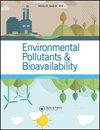尼日利亚西南部有机改良土壤中磷的形态和动态
Q3 Chemical Engineering
引用次数: 12
摘要
土壤磷素有效性是一个动态函数,可以通过有机改良剂来改善。本试验旨在研究禽粪(PM)对土壤磷组分和大豆(甘氨酸max)生物有效性的影响。来自尼日利亚西南部10个农民田地的土壤被用于培养和盆栽试验。5种浓度的PM处理(0、2.5、5.0、7.5和10 t / h - 1)。孵育和盆栽试验的三个重复单位采用完全随机设计。大豆连续生长3个生长周期,每个生长周期为7周,并对土壤样品进行了碱态磷、铝磷、铁磷、钙磷、封闭磷、还原性可溶性磷和残余磷的分析。结果表明,大多数土壤中铁磷是主要的活性无机磷,而残余磷是主要的非活性无机磷。在盆栽试验中,施用禽粪显著提高了第一个生长周期土壤中有机磷的含量,但在第二个生长周期中略有下降。Ayetoro和Odeda土壤样品有机磷含量最高,P≤0.05。在盆栽试验中,施用PM降低了土壤的固磷和封闭的磷组分。尽管其他形式的磷有增减,但大多数土壤的速效磷总体呈增加趋势。禽粪降低了磷的固定和封闭磷的释放。总体而言,禽畜粪便显著提高了土壤磷组分和植物磷组织浓度。本文章由计算机程序翻译,如有差异,请以英文原文为准。
Speciation and dynamics of phosphorus in some organically amended soils of southwestern Nigeria
Abstract Availability of soil phosphorus (P) is a function of its dynamics and can be improved by using organic amendments. Experiments were carried out to determine the effect of poultry manure (PM) on soil P fractions and bioavailability to soybean (Glycine max). Soils from ten farmers’ fields in Southwest Nigeria, were used for incubation and pot experiments. Treatments were five rates of PM (0, 2.5, 5.0, 7.5 and 10 t ha−1). Triplicate units in incubation and pot experiments were arranged in Completely Randomised Design. Soybean was grown for three consecutive growth cycles of seven weeks each and soil samples were analysed for Saloid P, Al-P, Fe-P, Ca-P, occluded P, reductant soluble P, and residual P. Results indicated that Fe-P was the dominant active inorganic P in the soils while residual P was the dominant inactive inorganic-P in most of the soils. In the pot experiment, application of poultry manure significantly increased organic P in the soils in the first growth cycle, but decreased slightly in second growth cycle. Highest and lowest (P ≤ 0.05) organic P values were observed in soil samples from Ayetoro and Odeda, respectively. In the pot experiment, application of PM reduced P fixation and occluded P fraction in the soils. There was general increase in available P in most of the soils considered despite increase or decrease in other forms of P. Poultry manure reduced the fixation of P and release of occluded phosphorus. Generally, Poultry manure significantly improved soil P fractions and plant P tissue concentrations.
求助全文
通过发布文献求助,成功后即可免费获取论文全文。
去求助
来源期刊
CiteScore
1.62
自引率
0.00%
发文量
0
审稿时长
1 months
期刊介绍:
Chemical Speciation & Bioavailability ( CS&B) is a scholarly, peer-reviewed forum for insights on the chemical aspects of occurrence, distribution, transport, transformation, transfer, fate, and effects of substances in the environment and biota, and their impacts on the uptake of the substances by living organisms. Substances of interests include both beneficial and toxic ones, especially nutrients, heavy metals, persistent organic pollutants, and emerging contaminants, such as engineered nanomaterials, as well as pharmaceuticals and personal-care products as pollutants. It is the aim of this Journal to develop an international community of experienced colleagues to promote the research, discussion, review, and spread of information on chemical speciation and bioavailability, which is a topic of interest to researchers in many disciplines, including environmental, chemical, biological, food, medical, toxicology, and health sciences.
Key themes in the scope of the Journal include, but are not limited to, the following “6Ms”:
Methods for speciation analysis and the evaluation of bioavailability, especially the development, validation, and application of novel methods and techniques.
Media that sustain the processes of release, distribution, transformation, and transfer of chemical speciation; of particular interest are emerging contaminants, such as engineered nanomaterials, pharmaceuticals, and personal-care products.
Mobility of substance species in environment and biota, either spatially or temporally.
Matters that influence the chemical speciation and bioavailability, mainly environmentally relevant conditions.
Mechanisms that govern the transport, transformation, transfer, and fate of chemical speciation in the environment, and the biouptake of substances.
Models for the simulation of chemical speciation and bioavailability, and for the prediction of toxicity.
Chemical Speciation & Bioavailability is a fully open access journal. This means all submitted articles will, if accepted, be available for anyone to read, anywhere, at any time. immediately on publication. There are no charges for submission to this journal.

 求助内容:
求助内容: 应助结果提醒方式:
应助结果提醒方式:


